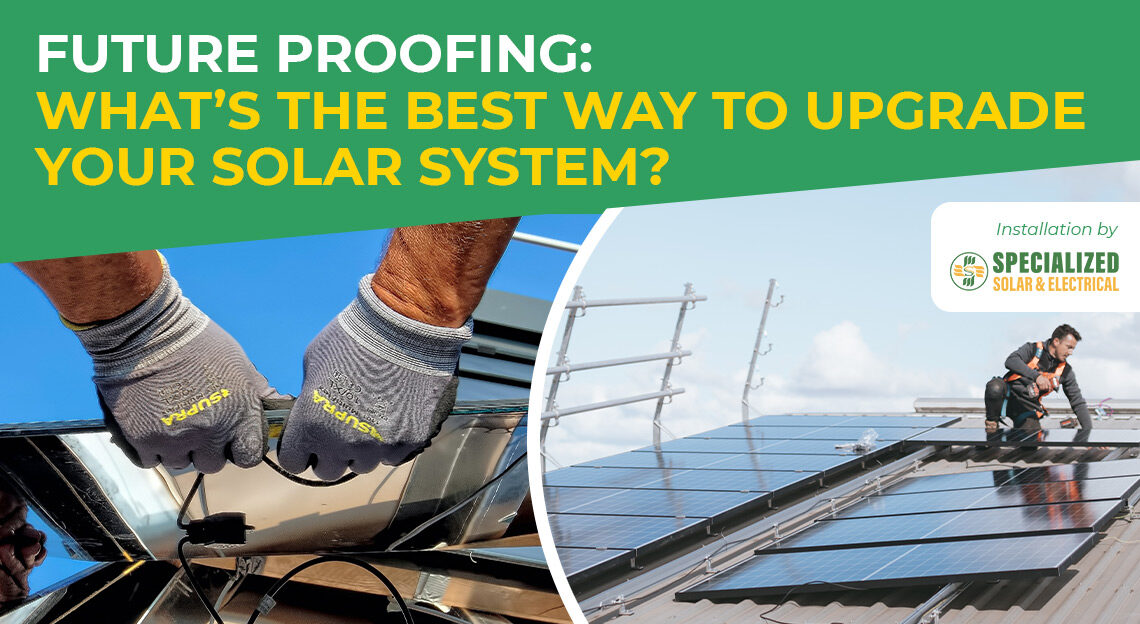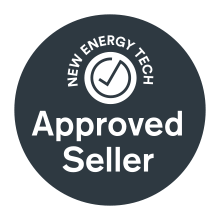With electricity prices rising, many people with older solar panel systems are thinking about upgrading. Whilst a few years ago, a 3kW, 4kW or even 5kW solar system would have seemed like the ideal size, today it’s definitely on the small side. In 2022, the average size solar power system installed on Australian homes is almost 9kW. That’s a dramatic increase from five years ago when it was around 3 or 4kW.
Future proofing with bigger solar
Anyone interested in protecting themselves from yet more energy price shocks, will be wondering what they can do. Clearly, a 4 or 5kW solar panel system isn’t going to produce enough electricity to charge a solar battery and an electric car. Neither is it going to provide the power for a typical all-electric family home.
So, upgrading to a bigger solar panel system is the logical next step.
Upgrade or replace?
But what’s the best way to upgrade your solar system? Is it possible to add more solar panels to an existing solar system? Or will you have to replace it and install a brand new system?
What you’ll learn from this blog
On this blog:
- Why is the age of my solar system so important?
- How big should I go with my solar upgrade?
- What do I need to know before I upgrade?
- Can my old system be recycled?
Why is the age of my solar system so important?
The age of your solar panel system is the biggest factor in determining whether you can upgrade your system – or if you to replace it with a completely new system.
The reason why age is so important is because electrical standards for solar systems have changed significantly over the last 10 years. Altering an existing system to bring it up to standard can be extremely expensive and, at times, simply not possible.
Generally speaking, if your solar system was installed within the last four or five years it should be possible to add another system alongside it. Whether you can – or not – will largely depend on available roof space and how much solar your local network distributor (the poles and wires company) will let you install.
If your system was installed five to seven years ago, it may be possible to increase your total system capacity, but this would have to be evaluated on a case-by-case basis.
However solar systems that are 7+ years old cannot be upgraded without a massive amount of work to bring them up to standard which would be expensive, and in many cases, not even possible. Almost invariably, the best approach to take them off and install a brand new system.
How big should I go with my solar upgrade?
This depends on your budget and available roof space.
If budget is not an issue – and you have space – we generally recommend covering your roof with solar panels. And we’re not the only ones saying this. These days, most solar industry experts are encouraging households to go as big as possible to prepare for an all-electric future.
However, if budget is an issue, our advice is generally to install around 8kW of solar panels. That should be enough to make a good dent in your energy bills and set up the typical 3-4 person home with enough power to charge a solar battery.
However, every home is different, and every household uses power differently. That’s why we would assess your roof, your energy usage and talk to you about what you want from a bigger solar system.
What do I need to know before I upgrade?
Here are the five most important points to check before going ahead with a solar upgrade:
1. Will I lose my premium feed-in tariff?
If you are on a premium feed-in tariff, it is important to evaluate whether upgrading to a bigger solar system is worth it. That’s because if you upgrade your system, you lose the premium feed-in and drop to the current standard feed-in (which is around 5c/kWh in Victoria).
Losing the premium feed-in tariff may be worthwhile if you aren’t exporting much solar to the grid. It may also be worth doing if you’re planning on getting battery storage or an EV. Although, the Victorian premium feed-in tariff is ending in 2024 so it doesn’t have much longer to run.
Deciding whether to forgo the premium feed-in is simply a question of doing the maths. It comes down to the cost and benefits of having a bigger solar power system versus staying on the smaller system with the higher feed-in tariff. Get in touch if this is your situation and we’ll be happy to run the numbers for you.
2. I have an oversized solar inverter. Can’t I just add more panels?
The answer to this is no. Because solar panels and standards for connecting them have changed, it is not possible to add more solar panels to an oversized solar inverter.
3. Will my network distributor let me install a bigger system?
Each network distributor (the poles and wires company) sets their own rules for how much solar power you can install on your home – and how much you can export to the grid. That goes for battery storage as well.
Generally speaking, you are allowed to install 10kW per phase and export 5kW of that. But the capacity of the battery can also be counted towards your total installed capacity.
It’s an area where you need to take expert advice as your choice of solar inverter could affect how much battery storage you can add later.
To avoid getting caught out, get in touch to find out what the solar connection rules are for your property.
4. Do I have enough roof space?
Roof space can be a limiting factor with solar. That’s why it’s important to make the most of every square meter. If you’ve got a small roof, replacing the old solar panels (which could be 200 or 250 watt) with new 415+ watt panels will give you around 30% more power per square meter. Even if you have a big roof, maximizing its potential with high output solar panels is going to pay off in the long run with more power and bigger savings.
5. Am I eligible for a solar rebate?
Solar rebates are available from the federal government for solar panel upgrades. Also, depending on the age of your old solar system, you may be eligible for a state government rebate as well.
Can my old system be recycled?
Yes, solar panels can be recycled in Victoria.
The solar panel recycling service we use is Lotus Energy in North Melbourne where they can recycle the majority of panels.
Many solar inverters can be reused as replacement inverters for broken down systems and this is something we’re definitely keen to encourage – and leave space for in our warehouse!
Request a quote
Get in touch with Specialized Solar & Electrical to get expert advice and a quote for upgrading your solar power system.












